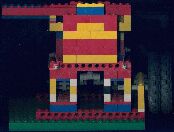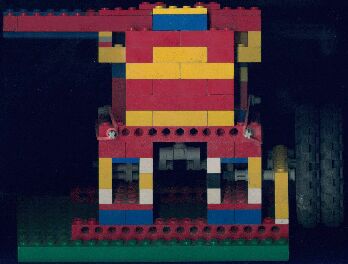 Prototype LEGO engine(1994)
Prototype LEGO engine(1994) 
 Prototype LEGO engine(1994)
Prototype LEGO engine(1994) 
 This is a side shot of the engine. You can see my vintage LEGO block
in the cylinder. I also used 2 of the Technic wheels from the Motorcycle
set for flywheels and some steering pieces in the crankshaft. On
either side of the cylinder, you can see the slider valves and the rubber
bands that act as low tension springs. The long piece going off to the
right of the picture is the air inlet tube.
This is a side shot of the engine. You can see my vintage LEGO block
in the cylinder. I also used 2 of the Technic wheels from the Motorcycle
set for flywheels and some steering pieces in the crankshaft. On
either side of the cylinder, you can see the slider valves and the rubber
bands that act as low tension springs. The long piece going off to the
right of the picture is the air inlet tube.
 Here is the other side of the engine. You can see the crankshaft
setup a little bit better and notice how the slider valves are in a little
different position than in the previous photo.
Here is the other side of the engine. You can see the crankshaft
setup a little bit better and notice how the slider valves are in a little
different position than in the previous photo.
 This is the
intake side of the engine. You can see the slider valve with rubber
band and the size of the air inlet tube in this shot. Sorry for the
shadow in the picture - I put the engine on the scanner instead of taking
an actual picture.
This is the
intake side of the engine. You can see the slider valve with rubber
band and the size of the air inlet tube in this shot. Sorry for the
shadow in the picture - I put the engine on the scanner instead of taking
an actual picture.
If you would like to see a cheesy still frame animation of this engine running, you can download the 460K zipped .avi file by clicking HERE.
The pictures on this page were created using an EasyPhoto ImageWave
scanner.
==================================================================================
Today I managed to successfully complete a 20
minute trial run of this engine. Compressed air was just way too
much for this engine to handle. It turns out that most of these LEGO
engines run best with an HVLP setup (High Volume Low Pressure) namely,
a wet/dry vac using the outlet side. I used some duct tape and taped
the output nozzle of my wet/dry vac to the intake port of the 1994 prototype
engine. Using a bench vise to hold the nozzle, I turned on the vaccuum,
spun the engine, and it ran continously for over 20 minutes until I shut
off the vaccuum.
I used trace amounts of silicon lubricant applied while the engine
was running to help it run smoother and reduce wear on the LEGO pieces.
Experimenting with the flywheels showed that using both wheels generated
the most power while using one wheel generated the most RPM's. The
engine generated enough torque to resist a mild yet firm touch of resistance
from my finger. A twin cylinder version would surely produce modest
power gains.
==================================================================================